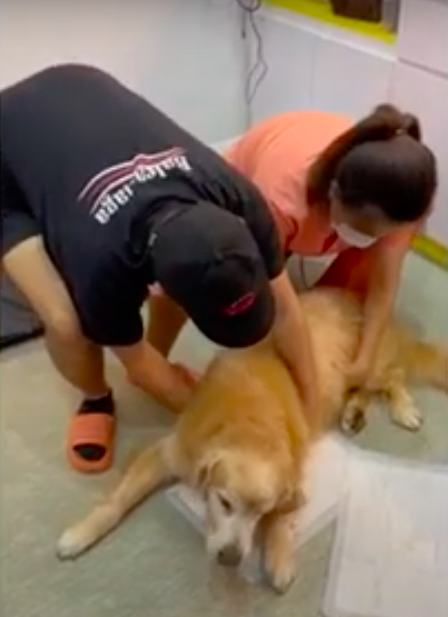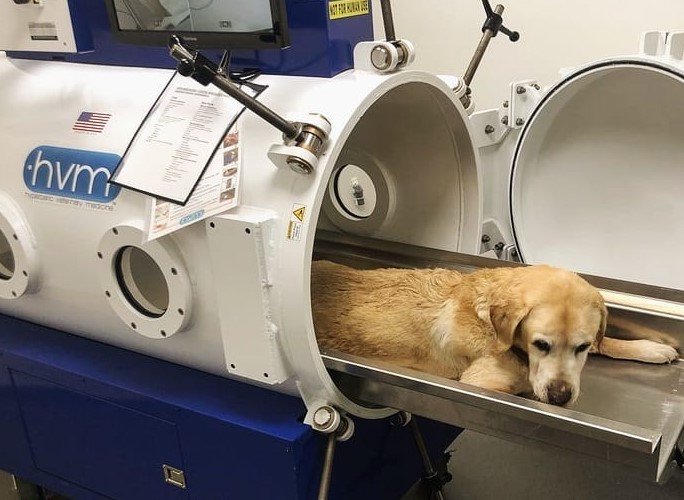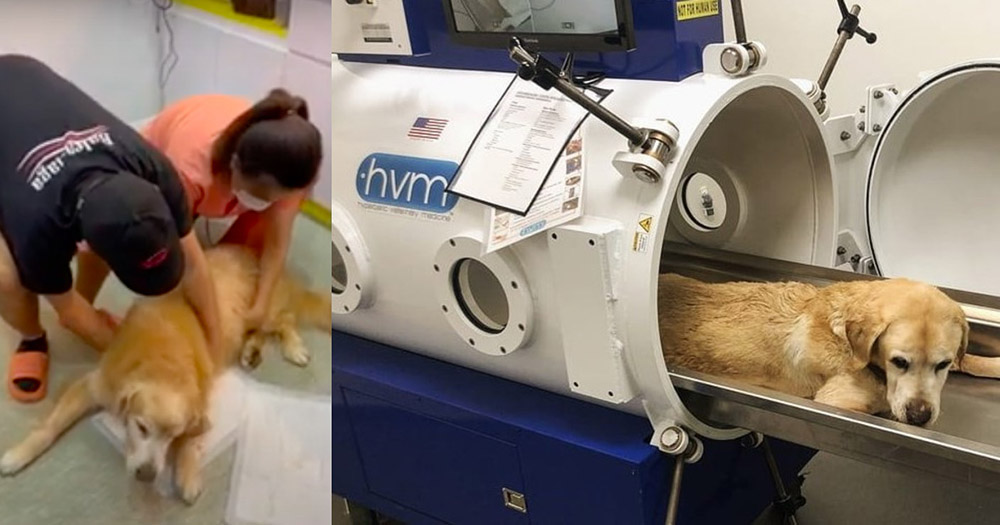If you are a pet owner, chances are you might have heard of vestibular syndrome – a neurological disorder in which your pet loses its sense of balance and spatial orientation.
This is what happened to Tyler, a 13-year old retriever.
On Jul. 24, 2022, Tyler was found by his owner to be lying on the floor, with his eyeballs twitching from left to right.
He appeared to be paralysed as he was unable to bear the weight of his body on his front left leg and both of his hind legs.
In addition, his head was tilted to the left, the owner highlighted.
The poor doggo also experienced nausea and became more subdued with a reduced appetite.
He struggled to get up with his hind legs over the next few days.
 Source: Image courtesy of RehabVet
Source: Image courtesy of RehabVet
How did Tyler become so seriously affected?
According to RehabVet, such a disorder is caused by a dysfunction in the vestibular system, which is composed of the inner ear, the vestibular nerve, and the brainstem.
This system is responsible for maintaining equilibrium, coordinating eye movements, and enabling the animal to maintain an appropriate body position in relation to its environment.
When the vestibular system is disrupted, animals such as dogs may experience a range of symptoms that can be distressing for both the animal and its owner.
Apart from the aforementioned symptoms, this also includes involuntary, rapid eye movements from side to side or up and down, known as nystagmus, and walking in circles or leaning to one side, usually towards the affected ear.
How was Tyler treated?
Initially, Tyler was first brought by his owner to their regular veterinarian, who performed a routine blood test to rule out other possible metabolic diseases and checked his ears for possible infections.
The golden retriever was then prescribed some anti-inflammatory medication, but this did not help him to regain mobility.
The owner’s friend then recommended that Tyler be brought to RehabVet clinic, where he was diagnosed with central vestibular syndrome. In particular, his tilted head could have resulted in permanent damage to the dog’s nervous system.
RehabVet also pointed out that the disease is idiopathic, which means the reason is unknown. However, it commonly occurs in geriatric dogs.
 Source: Photo courtesy of RehabVet clinic
Source: Photo courtesy of RehabVet clinic
Underwent 10 sessions of HBOT
Tyler subsequently started undergoing a rehabilitative form of therapy known as Hyperbaric Oxygen Therapy (HBOT) at the clinic, 10 days from the onset of his symptoms.
According to RehabVet clinic, HBOT is a non-invasive therapy that involves exposing patients to 100 per cent pure oxygen under two times the atmospheric pressure, within a specially designed, pressure-controlled medical grade chamber.
Within the chamber, the atmosphere is gradually increased to a level higher than normal, typically around two to three times the standard atmospheric pressure.
The chamber is also simultaneously filled with pure oxygen for the pet to breathe in.
This combination of increased pressure and pure oxygen significantly increases the amount of dissolved oxygen in the blood, which in turn allows for enhanced oxygen delivery to tissues throughout the body.
This includes increasing the amount of oxygen that is delivered to the brain, helping to improve cognitive function and reducing the risk of brain damage or cognitive decline.
It also helps to improve the body’s ability to recover from injuries, by speeding up the healing process and reducing inflammation.
In total, Tyler underwent 10 sessions of HBOT, over a period of three weeks, in which he was placed within the chamber for about an hour each time.
He was eventually able to make a full recovery and run by the 10th session, with his coordination restored, solely by undergoing HBOT.
The clinic added that for a successful HBOT treatment of vestibular treatment, it is important to bring in the pet within seven to 10 days from the onset of symptoms.
“The outcome is more predictable and recovery is more complete as soon as you see the symptoms appear,” the clinic's doctor, Sara Lam, said.
The only veterinarian clinic in Singapore to offer HBOT
Thus far, RehabVet is the only veterinarian clinic in Singapore to offer medical grade HBOT, as a result of RehabVet’s focus on animal rehabilitation.
The clinic was founded in 2019 by Lam, a veterinarian and member of the International Veterinary Academy of Pain Management and the American Academy of Veterinary Acupuncture, to provide rehabilitation services for animals with a wide range of conditions.
This includes post-surgery recovery, orthopaedic injuries, and neurological conditions, among others.
In highlighting that animal rehabilitation is a specialised field, Lam said the focus is on improving the mobility, function, and quality of life of animals that are recovering from injuries or illnesses.
As such, apart from HBOT, the clinic also offers Traditional Chinese Veterinary Medicine in the form of acupuncture, hydrotherapy for dogs, and manual therapy to help animals improve their overall health and fitness, including their emotional well-being, and to prevent diseases from occurring in the first place.
You can find out more about the various animal rehabilitation services offered by RehabVet here.
This sponsored article made the author consider sending his own cat for a check-up.
Top images courtesy of RehabVet
If you like what you read, follow us on Facebook, Instagram, Twitter and Telegram to get the latest updates.

